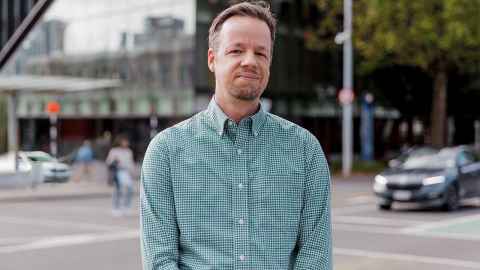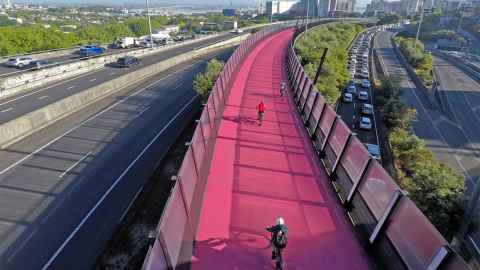Tim Welch: Why are we letting cyclists die preventable deaths?
2 May 2022
Opinion: Dr Tim Welch wants something done about New Zealand suffering deadly 'vehicle violence' brought about by poor infrastructure and fast-moving machines.

It was an ordinary Monday morning on 4 April, the start of a new work week as Melissa Rays rode her e-bike to her job at the family-run curtain hardware business in Auckland where she had worked for 20 years.
As she rounded a corner, some 150 metres from her destination, her bike and a van collided, and Melissa was killed. She was 58 years old.
A month earlier, on 5 March, University of Auckland student Levi James was killed on his way to visit his grandmother after a driver opened a car door, causing Levi to swerve into traffic while he was biking on Manukau Rd in Royal Oak. Levi was 19 years old.
As we rack up the number of road fatalities each year, deaths are assigned an innocuous name – the road toll.
This name obscures the horrendous human costs associated with our car-dominated society. For the past seven years in New Zealand, more than 300 people have lost their lives to ‘vehicle violence’. Typically, a dozen or so are pedestrians or cyclists. These deaths are – as are nearly all vehicle-related deaths – entirely preventable. However, the way cities have been built, the design of transportation systems, and the lack of infrastructure, pretty much guarantee deaths will occur.
We’ve built our cities to prioritise cars but cars weren’t always the dominant mode of transport on the road. It started with horse and cart, then bikes. When cars arrived on the scene in the 1920s and began to dominate in the 1950s, all other modes of transport were pushed off the roads.
When cars took over, the focus became building more roads, widening existing facilities and stretching them far into undeveloped lands. The intense focus on road building meant that good-quality footpaths and protected cycleways were an afterthought, if they ever were a thought.
These choices are part of what led to the deaths of Levi, Melissa and countless others. The lack of safe cycling infrastructure leaves cyclists vulnerable to heavy, sometimes erratic and fast-moving vehicle traffic. Levi and Melissa were relatively new to cycling, the start of a movement of people away from a car-dominated life – they were the brave ones willing to cycle in places most would consider inhospitable.
Other countries had the fortitude to implement plans that were initially unpopular but were for the greater good.

The lack of infrastructure has a profound effect on our transportation system.
Many people would be willing to bike to work, school, for shopping and recreation if they felt safe. Without the infrastructure to ensure safety, they are left to drive cars, unfairly becoming one of the many that may one day exact a toll on a pedestrian or cyclist. The only change they need is a bit of cement along some of the thousands of kilometres of road and have fewer cars on the street.
Of course, there is a better way. The good news is some cities are winning the battle against vehicle violence. Oslo and Helsinki have both achieved zero pedestrian or cyclist deaths. They did it under a programme called Vision Zero. While the programme has been derided as ineffective in some places, including Auckland, what sets Oslo and Helsinki apart is the number of approaches they used to implement it. Rather than just reducing speeds, which is where most cities stop, they also expanded public transportation, reduced car lanes, added cycleways and removed on-street parking. These policies effectively got more people out of their cars and saved lives.
Other cities like London, Stockholm, and Singapore have focused on reducing the number of cars entering the city and parking on the streets. Reducing the number of vehicles in cities is important as was evidenced by Levi swerving around the opening door of a parked car which landed him in fast-moving traffic.
Amsterdam and Copenhagen are often cited as the best biking cities in the world, but it wasn’t always that way. These cities were as full of cars as any New Zealand city in the 1970s, but around that time, their local governments decided to reprioritise people over cars in their cities. As a result, it’s normal – and completely safe – for people to use bikes as their only mode of transportation.
None of these places is physically, topographically or culturally radically different from New Zealand. They all started where we are now, with a growing concern over the safety of people navigating their streets. They differ in that they had the fortitude to implement plans that were initially unpopular but were for the greater good.
The car can toll for anyone. It’s not just New Zealand that suffers the violence brought about by poor infrastructure and fast-moving machines. Across the globe, more than 1.35 million people are killed through vehicle violence every year, half of whom are outside the car. The toll is more than a million sons and daughters, parents and grandparents, and people of all backgrounds – though disproportionately lower-income – losing lives that could have easily been prevented with a few changes in policies and priorities.
We owe it to Melissa and Levi and the many other lost lives to begin the process of putting people before cars and ending the cycling road toll.
This article first appeared in UniNews May 2022. It reflects personal opinion that's not necessarily that of the University of Auckland.